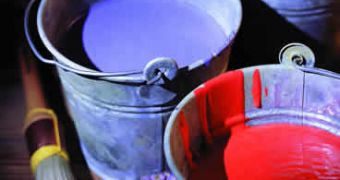A new discovery in the world of nanotechnology led to the production of a hard wearing and fireproof paint, by replacing the soap used to stabilize latex emulsion paints with nanotech sized clay armor. Latex is used in paint because it solidifies by coalescence of the polymer particles as the water evaporates and therefore can form films without releasing potentially toxic organic solvents in the environment.
The method developed by researchers at the University of Warwick's Department of Chemistry, replacing the traditional use of soap additions to overcome one major problem in latex paints, the polymer parts of the paint's aversion to water.
The University of Warwick chemistry researchers led by Dr Stefan Bon created a new and simple technique for stabilizing the paint and making it work, by individually coating the polymer particles used in such paints with a series of nanosized Laponite clay discs.
It's these disks that create a layer of armor atop of the individual polymer latex group and they can be applied with presently available industrial paint manufacture equipment. Having a diameter of only 1 nanometer (a nanometer is one billionth of a meter), the clay disks are individually small but extremely resistant as an ensemble.
Another advantage of these Lapointe clay disks, in addition to being an efficient alternative to soap, is their ability to produce highly wear-resistant and fire proof paints. The team envisions numerous industrial applications for their new process, like highly sensitive materials for sensors.
They say that they can burn away the polymer cores of the armored particles within a closely packed sample, to produce just a network of nanosized connected hollow spheres which provide an extremely useful surface area in a very small space.
This is exactly the characteristic required by compact but highly sensitive sensors to be produced in the near future.

 14 DAY TRIAL //
14 DAY TRIAL //